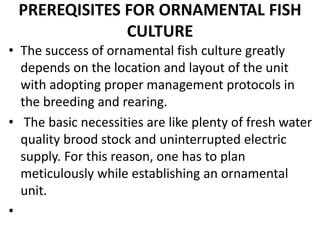Ornamental fish culture
- 1. Ornamental fish culture For Fish farmers by: B. Bhaskar Fisheries field officer, Mahabubabad, Ts ICAR-CIFA
- 2. Introduction • Ornamental fishes really are nature's wonderful creation. Ornamental fish keeping is the second most • preferred hobby in the world and the number of hobbyists for ornamental fish keeping is rising day by day • because it provides a great opportunity for entrepreneurship development and income generation. There are • a number of promotional schemes from various government agencies, which would boost up aspiring • entrepreneurs. The technology is quite simple and easy to take up and attain success.
- 3. PREREQISITES FOR ORNAMENTAL FISH CULTURE • The success of ornamental fish culture greatly depends on the location and layout of the unit with adopting proper management protocols in the breeding and rearing. • The basic necessities are like plenty of fresh water quality brood stock and uninterrupted electric supply. For this reason, one has to plan meticulously while establishing an ornamental unit. •
- 4. • For small scale culture a minimum of 500 sq.ft land area is required where the farmer can construct few rectangular concrete tanks. • For big projects more than 1ha land area is required and a numbers of earthen ponds required in addition to cement tanks for the culture of koi carp, catfish, gourami and barbs. • A shade facility is required above the cement tanks and anti-bird nets are required above the earthen ponds for breeding and rearing of ornamental fishes. • Sufficient water and electricity supply at the breeding and rearing units are important. • Selection of the quality brooder is the most important aspect for the success of the unit. • Some species reproduce in soft acidic water, while a few others prefer hard alkaline water to breed. • Livebearers usually prefer to breed in hard alkaline water, while fishes like Angel, Discus, Tetra, Oscar and Loaches prefer soft acidic water. • But other egg bearers like goldfish, danio, catfish, rosy barb, and fighter fish can tolerate a wide range of water. • Bio-filter is essential for proper water quality management in the production unit. • To increase breeding viability, avoid breeding of same fish for more than 2 years. Instead of that, fishes must be collected for far different places. • Farm made aqua pellets can be prepared by using different agricultural byproducts, for which a small pelletizer is required. The farmer can also use the commercial fish/prawn feed available in the market. • Live food like Zooplankton, Tubifex, Blood worms, Chopped Earthworms etc. are also very much essential for brood fishes and larvae.
- 5. • For proper marketing of fish, better communication facility (roadways/ rail/ airport) is required nearby to the farm. • Constant touch with small, middle, or large traders will benefit the farmer in marketing of his product. • Prospective farmers can avail training and new methods demonstration to get knowledge about the new know-how in their respective field of interest and expertise. • Integrated units like Ornamental fish- vermicompost, Vegetable cultivation/ backyard kitchen garden, Aquaponics can be adopted for better profit. • Few concrete and glass tanks are to be constructed at the entry of all fish farms for proper observation and quarantine before adding to the existing stocks. • Any unappealing situations like mass mortality or unidentified signs and symptoms among farmed fish must be attended immediately by taking advice for a specialist. • Highly alkaline or iron containing water must be avoided as many fish don't breed in such water
- 6. For beginners in ornamental fish breeding and farming • For beginners in ornamental fish breeding and farming • For beginners in ornamental fish breeding and farming, training on the subject is a prerequisite which will help to gain knowledge and market potential. • It is always better to begin with the livebearers like Guppy, Platy, Swordtail and Molly (as they breed easily) and after acquiring some experience, they can attempt for breeding and rearing of egg layers like Koi carp, gourami, goldfish, barbs, fighter fish etc. • It is always advised for a farmer to be master on a single species than venturing in to many species as they require different management practice.
- 7. CIFA technologies for ornamental fish culture • CIFA technologies for ornamental fish culture • CIFA has successfully bred and standardized the successful rearing of 16 indigenous ornamental species from NEH, Eastern and Southern Western ghat region comprising barbs, danios, rasboras, catfish and chameleon fish. • Recent achievement of captive breeding technology of an endangered fish Dawkinsia tamraparneii has been successful at CIFA leading to commercial production. • Development of”Shining barb” through selection process is one of the major achievement and in ornamental fish industry, now under field trial with a private company at Udaipur, Rajasthan. • Development of CIFACURE, a medicine for controlling fungal and bacterial diseases is gaining the momentum in many states of India. • CIFA is playing major role for conducting research and training programmes on freshwater ornamental fish breeding and culture in the country by conducting several national level training programmes both in and off-campus comprising more than 2000 participants from all over the country. • In addition to that many farmers also visit CIFA regularly for exposure to this area. • Development of “ornamental fish village” through community participation is also another area of success. • CIFA scientists regularly facilitates the new entrepreneurs in the development of viable business plans to establish ornamental units. • There are several governmental incentives and subsidies to start ornamental fish farming. NFDB provides 50% subsidy for establishing ornamental fish breeding and culture farms. • Hence a farmer can prosper more in this direction by availing the supports laid by the Government.







